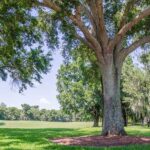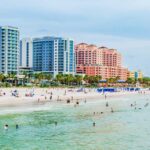Yes, it does snow in Florida! But it is extremely rare, especially in South Florida!
A unique combination of weather conditions and ocean activity are necessary for snow to fall in Florida. Because the northern Panhandle of Florida sits in a location where polar jetstreams can be received from the Gulf of Mexico and cold fronts from the Atlantic Ocean, this area is usually where most snowfall in Florida occurs. The snow in Florida, for the most part, comes in the form of snow flurries and melts almost instantaneously, though there are exceptions.
Snow in Florida is an extremely rare occurrence due to the state’s generally warm climate. However, it has snowed in Florida several times throughout history, typically during exceptionally cold weather events. Here’s a look at some of the most notable snowfalls in Florida’s history:
The Big Snow of 1899
-
Date: January 19-20, 1899
-
Details: This is often considered the most significant snowfall event in Florida’s history. The entire state experienced unusually cold weather, with snow reported as far south as Miami and Key West.
-
Impact: Snow fell in places that had never seen it before, and it accumulated up to 3 inches in parts of the state. This event is sometimes referred to as the “Great Blizzard” of 1899. It also caused a massive freeze, impacting crops and vegetation, especially citrus.
The Snowstorm of 1977
-
Date: January 19-21, 1977
-
Details: Snowflakes were reported in Tampa, Orlando, and other central Florida cities during a rare cold snap.
-
Impact: Snow didn’t accumulate much, but it was enough to stun residents, as it was the first time in over 100 years that the area saw snow. Some places had snowflakes fluttering for several hours.
I remember the snow in Miami in 1977! I was with my 6th grade class on our way to art class and someone yelled, it’s snowing! I had never seen snow before, like most of the kids in my class, so we were so excited! Our teacher took us outside, but we only caught the end of very few and scattered flurries. It was one of the most exciting, yet most disappointing days of that school year! The flurries were gone the second they hit the ground. We wanted more! But that was it. It was over.
The 1989 Cold Front
-
Date: January 1989
-
Details: A significant cold front pushed through Florida, causing temperatures to drop dramatically. Snow was reported in north Florida, including areas like Pensacola and Tallahassee.
-
Impact: While snowfall was light, it was enough to create a surprising sight in areas that rarely experience freezing temperatures.
The 2010 Snowfall in the Panhandle
-
Date: January 9, 2010
-
Details: On this day, snow flurries were reported in the Florida Panhandle, especially in Pensacola, due to a powerful winter storm.
-
Impact: Although there was no significant accumulation, it was a noteworthy event, with snow flurries observed in places where it hadn’t snowed in decades.
The 2021 Snow Flurries
-
Date: January 2021
-
Details: Snow flurries were observed in north Florida, particularly in areas like Tallahassee and Jacksonville, during a strong cold front that swept through the region.
-
Impact: This was a light dusting, and most of it melted quickly, but it marked another rare occurrence of snow in Florida.
2025 Record Breaking Snow Day
Snow in Miami (and the southernmost areas)
-
Snow has occasionally been reported as far south as Miami, though these events are typically extremely light and fleeting. One of the most famous reports came from Miami in December 13, 2010, where snow flurries were briefly spotted, though they didn’t accumulate.
Why Is Snow So Rare in Florida?
Florida’s subtropical to tropical climate makes it highly unlikely for snow to form. The state typically experiences mild winters, with average temperatures ranging from 50°F to 70°F (10°C to 21°C). Snow needs a combination of cold air and moisture, which is difficult to achieve in Florida’s climate. However, during certain cold fronts or extreme weather events, it is possible for snow to fall if conditions are right.
Factors for Snowfall in Florida
-
Cold Air Masses: For snow to occur in Florida, a large, cold air mass must move southward from the northern U.S. or Canada.
-
Moisture: Snow requires sufficient moisture in the air, which is harder to come by in Florida compared to more northern states.
-
Low-Pressure Systems: Snowstorms in Florida typically occur when a low-pressure system moves through, drawing in cold air and moisture from the Gulf of Mexico or the Atlantic.
Is Snow Likely to Happen Again?
While it’s difficult to predict exactly when or if snow will fall in Florida again, the state’s overall climate doesn’t favor snow. However, as climate patterns shift, extreme weather events, including cold fronts, could lead to rare snowfalls in the future. Most likely, snow would be confined to north Florida or the Panhandle, with central and southern Florida remaining unaffected.











